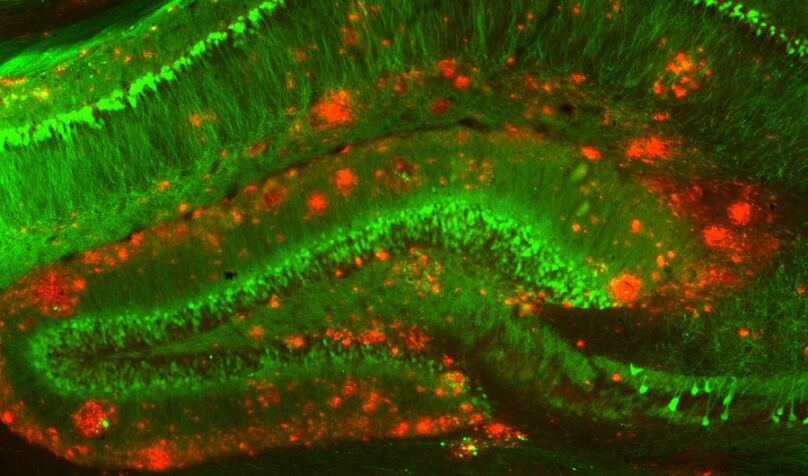Alzheimer’s Drug Trials Keep Failing -- It May Be Because We Don’t Understand the Disease

A memory-related brain region in a mouse model of Alzheimer’s disease. The green parts are neurons, while the red parts are amyloid beta clusters.
National Center for Advancing Translational Medicine via Flickr
(Inside Science) -- About a year ago, patients in a clinical trial of a Merck Alzheimer’s drug called Verubecestat received a phone call from their memory clinics.
“Stop taking the pills and return those left to the clinic immediately,” they were told. “The trial has been cancelled.”
My wife and about 1,500 Alzheimer’s patients around the world returned the containers of little blue pills back to their trial physicians.
A statistical analysis of the first three years of the study showed there was no chance the drug would work. The test was costing hundreds of millions of dollars with no hope it would ever help patients or come to market. Another promising anti-Alzheimer’s drug had failed.
Last month, the drug giant Pfizer halted all its Alzheimer’s
There are currently only five
Multiple trials, many misses
Virtually all clinical trials of Alzheimer’s drugs fail; in contrast, almost half of cancer drugs tested have a positive effect
Behind almost all the Alzheimer’s drug tests is the amyloid theory. People suffering from the disease have a protein called “amyloid beta” accumulating in their brains in the form of brain cell-killing fibers. Researchers have known about these amyloid beta fibers since Alois Alzheimer and Emil Kraepelin found them in the brain of a German woman suffering from early dementia in 1901. The two researchers also found tangles of a protein now known as tau in her brain at autopsy. Neither Alzheimer or Kraepelin knew what caused the degeneration, and scientists have been debating this question ever since.
The tau tangles seem to be influenced by amyloid plaques.
The amyloid and the tau have been the center for most research and clinical trials, said Mony De Leon, director of the Center for Brain Health at the NYU Langone Medical Center.
Normally, the two proteins are washed away into the spinal fluid. But in Alzheimer’s patients, they build up in the brain, and the theory is that this accumulation causes Alzheimer’s symptoms. If you turn off the spigot and stop the development of new beta amyloid, you halt the disease.
The theory is a bit rickety. Some people with all the symptoms of Alzheimer’s disease do not have a buildup of beta or tau in their brains, and some people have the buildup but no symptoms.
A common disease among Americans
There are several forms of the disease
“Even though the familial disease looks really, really similar to the sporadic disease, there’s a chance that it’s not,” said Michael Murphy, associate professor at the Sanders-Brown Center on Aging at the University of Kentucky, in Lexington.
In sporadic Alzheimer’s disease, researchers have long suspected that the problem is that the brain cannot get rid of the amyloid quickly enough, while in familial, they believe the problem is overproduction, said de Leon.
In contrast to the traditional theory that attributes everything to amyloid and tau, Murphy thinks there is evidence the amyloid is just part of the process, perhaps the trigger that sets in motion a whole cascade of events that leads to Alzheimer’s. That process is likely far more complicated than supposed, he said. “I’m thinking it’s an early trigger,” Murphy said.
One analogy to the theory behind the search for an effective drug, according to Costantino Iadecola, professor of neurology at Weil Cornell Medical Center in New York, is a flooded apartment caused by a broken pipe and a clogged drain. The obvious way to solve the problem is to fix the pipe and open the drain -- in other words, to stop the flow of amyloid and at the same time find a way to wash it from the brain.
Most of the drugs aimed at Alzheimer’s disease have tried that. It hasn’t worked.
For instance, a study
Another factor is that scientists have found the accumulation of the amyloid begins decades before the first symptoms, Iadecola said. The brain compensates for the damage for years, and only when its plasticity is exhausted do the cognitive symptoms show. By then, he said, it’s too late. The damage is done.
The drugs all fail, perhaps because that model is wrong.
Also, most of the early testing is done on mice, and it is possible that the mouse version of the disease, created by genetic engineering, is not the same as the human disease, Murphy said. What works on mice might not work on people.
The need for innovation
Most of the concentration has been on the amyloid, and Iadecola said not enough has been aimed at the tangles of tau protein. Both are natural proteins, purpose unknown, and it would be difficult to turn them off, de Leon said.
The trick is to consider the biology of time -- intervene before the damage begins, in other words.
Thanks to modern imaging and breakthroughs in genetics, it is possible to spot people most likely to get Alzheimer’s disease. They could be monitored with imaging so any intervention could come when it would do the most good. That intervention would be similar to giving potential heart attack and stroke victims statins, which prevent accumulation of cholesterol plaques in the blood.
Other avenues are being tested, including enlisting the immune system to fight the tangles. One might be able to increase the clearance of tangles, potentially by improving sleep and controlling blood pressure, de Leon said.
In an editorial
For patients like my wife, who are in what Ronald Reagan called “the sunset of my life,” there is little hope. For people who are statistically more likely to get Alzheimer’s Disease, the hope may lie in prevention.


